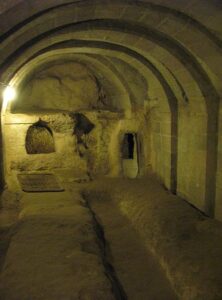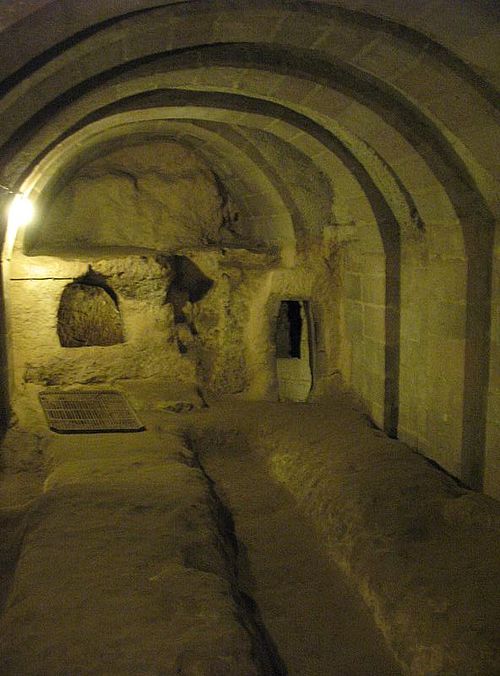
What is special about the rock in Turkey? Most of the rock in Turkey is just regular rock, but some of it is soft volcanic rock that is easy to carve and sets harder than concrete. This is not just in Turkey, but a lot of it has been found there.
In Turkey, there are a lot of structures made by carving this soft volcanic rock. There are also incredible tunnel complexes that extend far underground. The tunnels are basically an underground city that goes 80 m down and extends much further than has been explored so far. It is thought that thousands of people could have lived in these complexes. It would have kept them out of the heat in the summer, the cold in the winter, and it would have protected them from any invading forces. It would have been dark and possibly claustrophobic, but it would have been safe. They lit the tunnels and caves with linseed oil lamps. They even had enough space to keep their horses and cattle safe.
This particular type of rock is called tuff. Tuff is made from all of the material that is ejected from a volcano when it erupts. The majority of tuff is made from volcanic ash, which is very hot, but cools to become hard. In fact, the rock has to have more than 75% volcanic ash to be called tuff. Any less and it is only “like tuff”. Volcanic ash is a mix of tiny pieces of rock, other minerals, and glass particles. Each piece is smaller than 2 mm. The ash is mixed with steam and carbon dioxide as well, which means that when it hardens it is very porous and not very dense. Closer to the volcano, there might be larger rocks and pieces of debris that come down with the ash. When the ash settles on the ground, it cools and hardens, forming tuff. A lot of this ash is ejected from the volcano in an upwards direction, but a lot also comes out in the pyroclastic flow. Pyroclastic flow is hot ash, lava, and gas that flows over the edge of the volcano and pours down the sides. It behaves like a fluid and follows the line of the ground, although it travels extremely quickly, moving at hundreds of kilometers an hour. It can reach up to 1,000 ℃. Often, one of the most dangerous parts of a volcanic eruption is the pyroclastic flow. The force of it knocks things over, it burns everything, and then it buries what’s left in a thick layer of ash. It was the pyroclastic flow from Vesuvius that buried Pompeii. When all of this ash cools, it forms tuff.
Tuff is remarkably strong, but it is also very easy to carve. It can even be carved with ancient tools. Once it has been carved, it stays hard and is a very strong substance. Many of the buildings and caves made of tuff will probably still be standing long after the rest of our buildings have collapsed.
There are several buildings carved out of tuff in Turkey. One of them is the tunnel complex I already mentioned. The first caves were probably dug out of the tuff in the 9th century BC. The tunnels got longer and deeper until there were several layers of them. Each layer connected to the one above it with a very narrow stairwell that people needed to duck to use. This was to stop invaders because they would have to go up in single file and they could be fought off more easily. By 800 AD, underground cities had sprung up and they were connected to each other along tunnels that stretched 9 km. At least 40 cities have been discovered so far, but there are probably many more that have been lost. One of the complexes was only found again by accident when someone knocked through a wall in their house and found a room they didn’t know about that led into a tunnel. Another type of building are ones carved out of the rock face. The majority of the building was carved out inside the cliff, but the face of the building was carved into the rock face. There are a lot of buildings like this. Turkey isn’t the only place to have building carved out of cliff faces.
If it hadn’t been for such soft easily carved volcanic rock, the culture of the area would probably be very different. And this is what I learned today.
Sources
https://en.wikipedia.org/wiki/Rock-cut_architecture_of_Cappadocia
https://en.wikipedia.org/wiki/Tuff
https://education.nationalgeographic.org/resource/pyroclastic-flow
https://education.nationalgeographic.org/resource/volcanic-ash
https://www.tufi.ge/index.php/en/1-what-is-tuff
https://en.wikipedia.org/wiki/Derinkuyu_underground_city
Image By Martijn Munneke from Netherlands – Derinkuyu – schoolUploaded by stegop, CC BY 2.0, https://commons.wikimedia.org/w/index.php?curid=10483090

